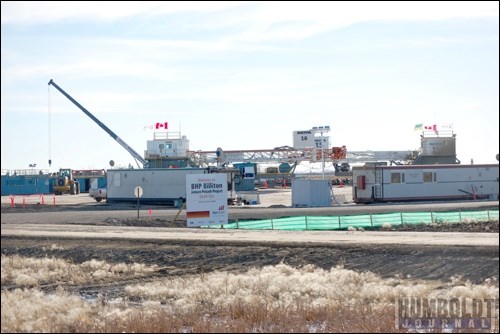The Jansen project will go ahead whether or not they get to buy another company.
Representatives from BHP Billiton were in LeRoy on November 1 meeting with community leaders to provide an update on the proposed potash mine at Jansen and on the company's bid to buy PotashCorp.
The meeting was organized by the RM of LeRoy and the RM of Prairie Rose to allow other municipal leaders, as well as businesses and local organizations, including the RCMP, to ask questions about the two topics.
Morris Hartman, Mayor of the Town of LeRoy, said the meeting was important because the region will be hugely impacted by the construction of the new mine at Jansen and everyone needs to prepare for that impact.
Graham Kerr, the president of diamond and specialty products with BHP, spoke first, explaining a few details about the company, including the fact that it is the sixth largest company in the world with 100 different operations in 25 countries.
BHP sees potash as a new way to grow and the company has been researching the product and the industry since about 2002, he explained.
"This is a long-thought-out strategy and we see the commodity as having a long way to grow," Kerr said.
The company is basing their expectations of growth on the emergence of growth in third world and developing countries, such as China and India, he noted.
Having more and better food is usually the third generation of growth in those countries and BHP, which supplies the commodities for the first two generations of growth - infrastructure such as roads and then improved comforts in homes such as running water - believes those countries are in the first stages of the third generation.
"There are more people and less land in the world and people are changing their eating habits," Kerr said. "All of that will drive potash prices up."
All of those factors combine to create a growing demand for potash, one which BHP sees as an opportunity for growth in the industry, leading to their development of the Jansen project.
The Jansen project itself hasn't moved as quickly as they would have liked, noted Derek Chubb, manager of sustainability and external affairs with BHP.
"It's been a tough year on site in terms of the weather," he said.
But, the four drills which will start drilling the 40 bore holes for each of the two shafts for freezing the ground should be in place this month, Chubb said. That will be a four- to five-month process, which is part of their Environmental Impact Statement (EIS). BHP plans to submit their EIS to the provincial government for approval before the end of the year, Chubb added.
If the government gives the go-ahead to the mine, they plan to start construction in late 2011.
Right now, the planning for the introduction of utilities such as water, power, and rail, are underway and all are on different timelines, Chubb said.
As well, the realignment of the grid road through the site is 小蓝视频 discussed with the RMs.
The current grid road will be in the middle of the project, so BHP is working with the RMs to improve the roadways to the site and provide an alternate route for people to use to get around the site.
The first roads to be improved will be the access road from Hwy. 6 to the site, running east and west, and the north half of the realigned grid.
That will only be the start of the road construction necessary to move traffic smoothly to and around the site, it was noted.
BHP and the two RMs are working on a memorandum of understanding on the roads which includes a five-year plan, explained Jerry McGrath of the RM of LeRoy.
BHP focused on the impact the new mine will have on the region, stating that they expect the up to 1,000 permanent workers at the mine will be expected to live in the surrounding region and not drive in from Saskatoon. As well, BHP will go ahead with the Jansen project whether or not they get permission from the federal government or not to buy PCS, said Kerr.
With that in mind, most municipal leaders were asking what they could do to attract families and how BHP could help them out.
"We will share our information with the communities," Chubb said. "We know what's there and what the gaps are and we are working with governments and organizations to close the gaps."
Building mines in areas where there are no big cities nearby is not a unique situation for BHP, said Kerr. They are used to working with the people who are already in the communities to accommodate growth, he added.
To deal with the large number of workers involved in the construction of the mine - up to 1,900 at its peak - BHP will be setting up a work camp.
When asked about whether or not BHP will be using Canpotex - the marketing arm used by the three main potash companies in the province - Kerr said if they don't takeover PotashCorp, then they won't be using it. If they do acquire PotashCorp, then they might use it, but the group is almost at the limit of its carrying ability, he noted.
Kerr was quite forceful, stating several times that the Jansen project will go ahead whether or not the takeover of PotashCorp proceeds.
Kerr would not share any details of BHP's discussions with the federal government and Investment Canada.
"We've talked to the Saskatchewan government and the federal government and we've laid out a series of net benefits," he said. "If we're successful, we will work with the premier and the people of Saskatchewan. We already see the province as our existing partner on the Jansen project."




